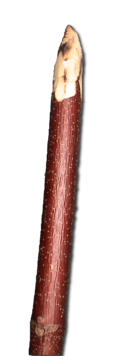- Digging stick
-
In archaeology and anthropology a digging stick is the term given to a variety of wooden implements used primarily by subsistence-based cultures to dig out underground food such as roots and tubers or burrowing animals and anthills.[1] They may also have other uses in hunting, farming or general domestic tasks.
They are common to the Indigenous Australians but also other peoples worldwide and normally consist of little more than a sturdy stick which has been shaped or sharpened and perhaps hardened by being placed temporarily in a fire. It's a simple device, and has to be tough and hardy in order not to break.
In Mexico and the Mesoamerican region the digging stick was used for traditional agriculture such as for cultivating maize, and still is used for agriculture in some indigenous communities. It is known as a coa stick in this area and usually flares out into a triangle at the end. Some newer 20th century versions have added a little metal on the tip. Digging sticks were the most important agricultural digging tools used in Mesoamerica and throughout the ancient Americas.
References
- ^ The American Heritage Dictionary of the English Language, Fourth Edition. Retrieved July 24, 2008, from Dictionary.com website: http://dictionary.reference.com/browse/digging stick
2. http://www.mexicolore.co.uk/index.php?one=azt&two=art&tab=two&typ=reg&id=377 3. http://www.mexicolore.co.uk/index.php?one=azt&two=art&id=320&typ=reg
Categories:- Anthropology
- Stone Age
- Indigenous peoples of Australia stubs
- Archaeology stubs
- Agriculture stubs
Wikimedia Foundation. 2010.

